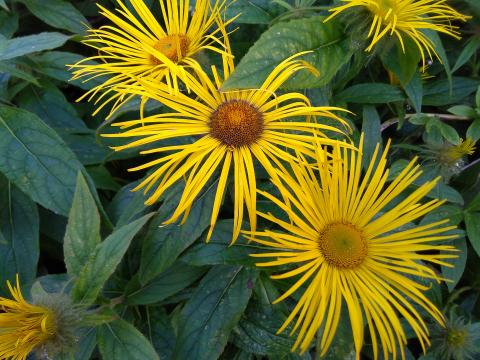Elfwort

This is elfcampene, elfdock or elfwort. As some of its names suggest, this curious and beautiful flower was associated with elven folk, those mysterious but powerful beings said to dwell in woodlands and by rivers. In Norse and Germanic mythology, they’re sometimes mischievous, or evil; sometimes they are benevolent or ambivalent towards humans. In Tolkien’s middle earth books, chiefly Lord of the Rings, they are a wise and beautiful race of super-humans, distressed by man’s corruptibility. In American-based Christmas myths, a group live at the North Pole assisting Santa Clause with the manufacture and distribution of children’s gifts.
All sorts of explanations exist for the origin of these legends and myths and belief in such creatures was common up until the nineteenth-century. I wonder if it was a distant memory of angels, powerful beings sent to aid and benefit humans, some of whom became even more evil than even our own fallen ancestors.
Elfwort is a flower known for its healing properties, like so many others. In France and Switzerland, in contrast, it was used in the manufacture of absinthe, an alcoholic beverage so powerful, it’s little better than poison. Just as some angelic beings remain on kindly terms with humans, while others offer destruction and pain, so this plant has had many different uses. My advice is to leave it well alone, only enjoying it from afar. One day we shall enjoy angels’ company and maybe understand what drew some of them away from God’s service. Until then, leave well alone.
Yet these people slander whatever they do not understand, and the very things they do understand by instinct—as irrational animals do—will destroy them. Jude 10, NKJV.
- Log in to post comments


 Sunday Worship 10.45am & 6.00pm
Sunday Worship 10.45am & 6.00pm